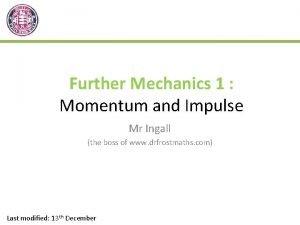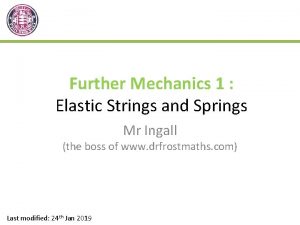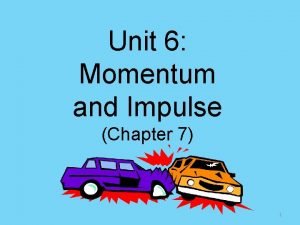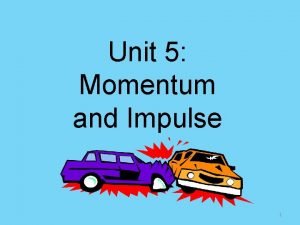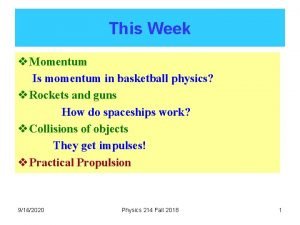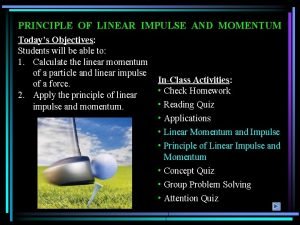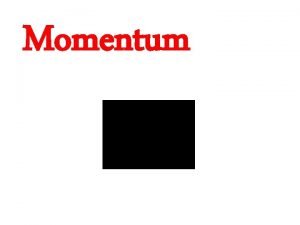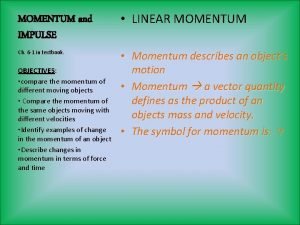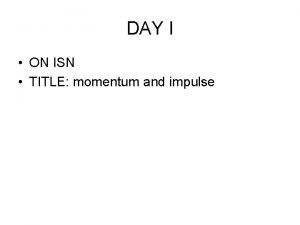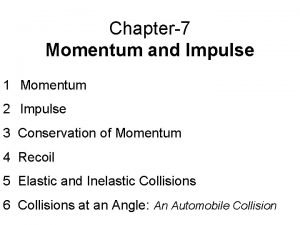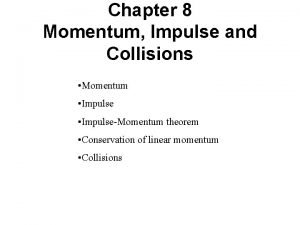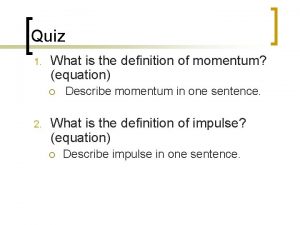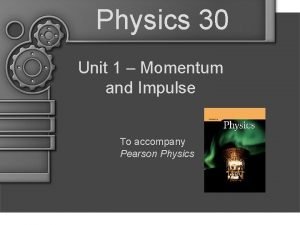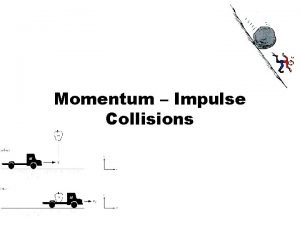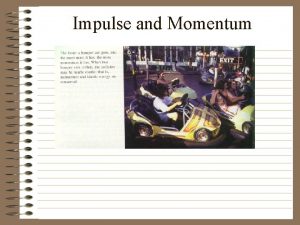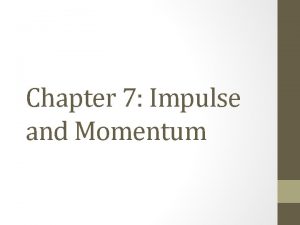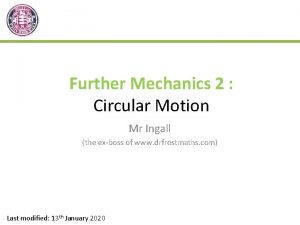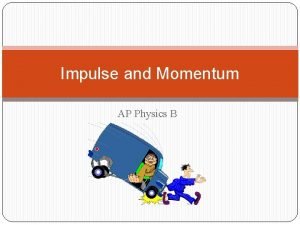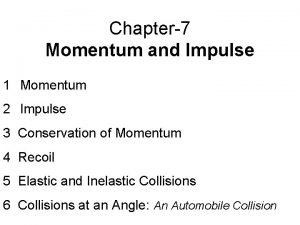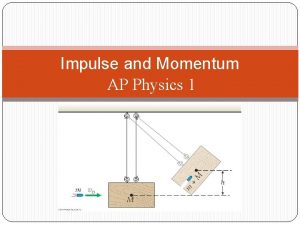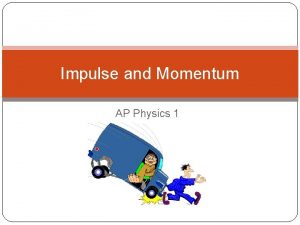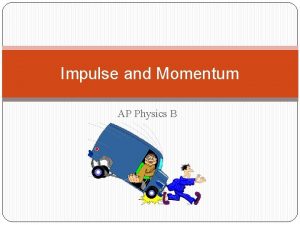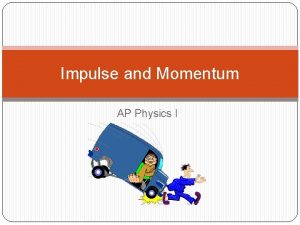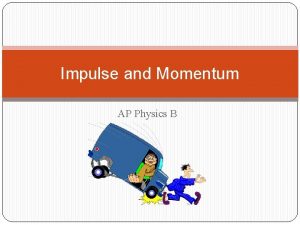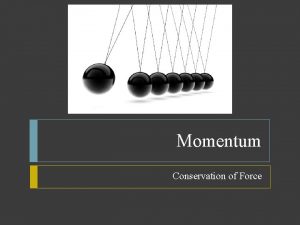Further Mechanics 1 Momentum and Impulse Mr Ingall






![An Example [Textbook] A ball of mass 0. 2 kg hits a vertical wall An Example [Textbook] A ball of mass 0. 2 kg hits a vertical wall](https://slidetodoc.com/presentation_image/95c8337e1729279a4cb1ce8c513040a0/image-7.jpg)











- Slides: 18

Further Mechanics 1 : Momentum and Impulse Mr Ingall (the boss of www. drfrostmaths. com) Last modified: 13 th December

What do we understand by Momentum? Two identical cars are driving – one at 100 km/h and the other at 30 km/h. Which has greater momentum? 30 km/h 100 km/h The 100 km/h car – higher speeds are associated with higher momentum ? Both the car and the lorry are driving at 50 km/h. Which has greater momentum? 50 km/h The lorry – greater mass is associated with greater momentum ? 50 km/h

Defining Momentum Jonah Lomu the famous All Black winger was the personification of momentum: He was lightening quick 1 AND massive 2 ! Definition of Momentum: Although never used in A Level Maths P can be used to represent momentum. ? Momentum is a vector quantity: the direction will be the same as the velocity. Momentum is measured in kgms-1 or Ns These units are equivalent as N = kgms-2 (F = ma) 1. His PB for 100 m 10. 7 s 2. He was 6 foot 5 inches tall and weighted 19 stone

Quickfire Momentum Fill in the gaps in the table below (if possible give momentum as a vector, otherwise find the magnitude of momentum. Mass Velocity Momentum 6 kg 5 m/s 30 Ns 1. 2 tonnes 0. 8 ms-1 5 kg 13 ms-1 ? ? 523 kg 0 m/s 3 kg 4 i + 7 j ms-1 600 g 36 km/h 2 kg ? 20 kg 3 i + 9 j ms-1 7 i + 7 j ms ? -1 ? 960 Ns? 65 kgms-1 0 Ns 12 i + 21 j ms ? -1 6 Ns ? 6 i + 18 j Ns 140 i + 140 j kgms-1

Defining Impulse If a constant force is exerted on an object for a given time the impulse exerted is defined as: Impulse has the same units as momentum = change in momentum Impulse Known as the impulse-momentum principle Tip: Beware of signs! Define one direction as positive and all velocities in the other direction are negative. To understand that: Impulse = Ft = change in momentum Picture a strong man pulling an aeroplane! The momentum gained by the aeroplane depends on: - How hard the man pulls (Force) - How long he pulls for (Time) Often a reasonable impulse is the result of a very large force acting for very short time (e. g. a bat hitting a ball) in these cases it is easier to calculate the change in momentum.

Quickfire Impulse Calculated the impulse exerted on the object in the following cases: 1. A force of 30 N is exerted on an object for 0. 5 s 2. A ball of mass 3 kg was travelling at 10 m/s is hit and slows to 6 m/s without changing direction. 3. A ball of mass 3 kg was travelling at 10 m/s is hit so that it returns in the opposite direction at a speed of 6 m/s 4. A rocket of mass 100 kg travelling at 2000 m/s hits the ground and stops. 5. The momentum before impact is 6 i + 3 j Ns and the momentum after impact is 10 i + 5 j Ns 6. The momentum before impact is 6 i - 5 j Ns and the momentum after impact is 10 i + 5 j Ns 15 Ns? 12 Ns? 48 Ns? 200000 Ns ? 4 i + 2 j ? Ns 4 i + 10 j ? Ns Tip: In situations where the direction changes the magnitude of the impulse should be larger
![An Example Textbook A ball of mass 0 2 kg hits a vertical wall An Example [Textbook] A ball of mass 0. 2 kg hits a vertical wall](https://slidetodoc.com/presentation_image/95c8337e1729279a4cb1ce8c513040a0/image-7.jpg)
An Example [Textbook] A ball of mass 0. 2 kg hits a vertical wall at right angles with a speed of 3. 5 ms -1. The ball rebounds with speed 2. 5 ms-1. Find the magnitude of the impulse exerted on the wall by the ball. The thinking behind the problem 3. 5 The solution 2. 5 Tip: A quick diagram can help visualise the problem

Test Your Understanding Edexcel M 1 Jun 2007 Q 2 a ?

Exercise 1 A Pearson Further Mechanics 1 Pages 3 -4

The law of Conservation of Momentum ! The law of Conservation of Momentum In an isolated system: 30 km/h 100 km/h Total momentum before impact = Total momentum after impact Proof: Before Diagram? After ? ? 1 2 Tip: Start by drawing a diagram - do it quickly free hand - make it a decent size - Velocities: use single arrows detached from bodies - Impulses: use arrows attached to bodies (like forces) 1 2 ? 1. An isolated system is a collection of bodies which only experience unbalanced forces from other bodies in the system.

Quickfire Conservation of Momentum Calculated the value of the unknown in the following isolated systems. All velocities marked are in m/s and all masses in kg. 3 1 2 1 1 3 1 2 1 ? ?

An Example 4 0 8 2 Diagram for a? Solution to a) 0 2 Diagram for b? Solution to b)

Test Your Understanding Edexcel M 1 Jan 2014 (I) Q 1 ?

Exercise 1 B Pearson Further Mechanics 1 Pages 7 -9

Momentum as a Vector Mass and time are scalar quantities. Momentum, Force, Velocity and Impulse are all vector quantities. For one dimensional questions all direction is simply + or -. For two dimensional questions, all the equations from this chapter can be used with vectors. You can work separately with i, j (and k) components. Impulse = change in momentum I = m(v – u) Þ 3 i – 2 j = 0. 2(v – (10 i – 5 j)) Þ 15 i – 10 j = v – (10 i – 5 j) Þ 15 i – 10 j + 10 i – 5 j = v Þ v = 25 i – 15 j ? dividing both sides by 0. 2 adding 10 i – 5 j to both sides collecting i and j terms separately

Momentum as a Vector To find the magnitude of a vector (e. g. Impulse Momentum) use Pythagoras To find the direction of a vector use trigonometry Tip: Remember if the question asks for speed, this is the magnitude of velocity, if it asks for distance this is the magnitude of displacement. 0. 85 ? Q 2. 04 Tip: Diagrams help when finding directions

Test Your Understanding Edexcel M 2 Jan 2012 Q 1 ? Riddle: (VIM + VI) + 0 + +

Exercise 1 C Pearson Further Mechanics 1 Pages 11 -12
 Further mechanics 1 unit test 1 momentum and impulse
Further mechanics 1 unit test 1 momentum and impulse Ceiiinosssttuu
Ceiiinosssttuu Physics 03-01 work and the work-energy theorem
Physics 03-01 work and the work-energy theorem Unit 6 momentum and impulse
Unit 6 momentum and impulse Unit of momentum and impulse
Unit of momentum and impulse Basketball impulse and momentum
Basketball impulse and momentum Linear impulse momentum equation
Linear impulse momentum equation Principle of linear impulse and momentum
Principle of linear impulse and momentum The importance of momentum
The importance of momentum Poem about impulse and momentum
Poem about impulse and momentum Impulse and momentum relationship
Impulse and momentum relationship Importance of momentum and impulse
Importance of momentum and impulse Impulse momentum
Impulse momentum Unit for momentum
Unit for momentum Unit for momentum
Unit for momentum Momentum units
Momentum units Momentum and impulse physics 30
Momentum and impulse physics 30 Impulse and momentum
Impulse and momentum Ap physics momentum and impulse
Ap physics momentum and impulse
